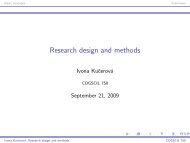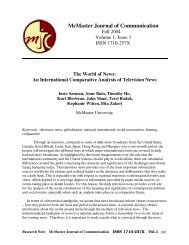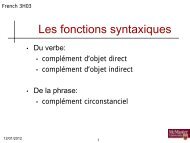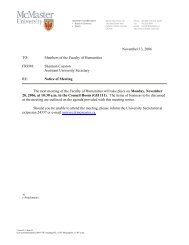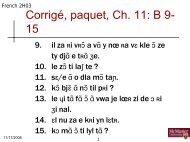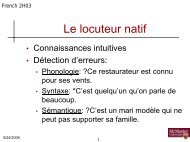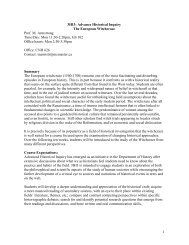The Syntax of Givenness Ivona Kucerová
The Syntax of Givenness Ivona Kucerová
The Syntax of Givenness Ivona Kucerová
Create successful ePaper yourself
Turn your PDF publications into a flip-book with our unique Google optimized e-Paper software.
derivations are syntactically well-formed. Such a condition is not strictly speaking a part <strong>of</strong><br />
the evaluation component, but it is a necessary precondition for a derivation to be considered<br />
for evaluation. <strong>The</strong> reason why the constraint belongs here, however, is that licensing<br />
<strong>of</strong> G-movement happens only at the interface.<br />
(72) SYNTAX:<br />
the reference set may contain only grammatically well-formed structures<br />
<strong>The</strong>n we need to guarantee that the relevant presupposition would be maximized. This<br />
requirement consists <strong>of</strong> the interaction <strong>of</strong> two separate requirements: (i) mark everything<br />
given as presupposed (make sure that each given element would give rise to the desired<br />
presupposition), and (ii) avoid marking new elements as presupposed (avoid Presupposition<br />
failure). I will call this constraint INTERPRETATION.<br />
(73) INTERPRETATION:<br />
a. a given element must be marked as presupposed (either lexically or by a G-<br />
operator) [≈ Maximize Presupposition]<br />
b. a new element cannot be marked as presupposed [≈ Presupposition Failure]<br />
We are now in a position to evaluate the system in place and see whether it can account<br />
for the facts we have considered so far. Let’s start with a simple case <strong>of</strong> a ditransitive<br />
construction in which everything is given except for the indirect object. Since in Czech<br />
a direct object follows an indirect object, it is enough if the direct object moves above<br />
the indirect object. <strong>The</strong> desired interpretation is given in (74). <strong>The</strong> boxes correspond<br />
to elements that we want to be interpreted as given; the structure is presented in the basic<br />
Czech word order. <strong>The</strong> relevant reference set is given in (75). I list here and in the following<br />
examples only a few candidates that are most relevant for the evaluation. <strong>The</strong> first candidate<br />
is a derivation in which no G-movement takes place and no G-operator is inserted, (75-a).<br />
<strong>The</strong> second candidate is a derivation with a G-operator inserted above the indirect object but<br />
with no G-movement, (75-b). <strong>The</strong> third candidate is a derivation with local G-movement <strong>of</strong><br />
the indirect object and a G-operator adjoined immediately below the moved object, (75-c).<br />
<strong>The</strong> last candidate differs from the previous candidate in that G-movement is not local, but<br />
instead the movement is cyclic and crosses several given elements, (75-d).<br />
(74) Desired interpretation:<br />
Peter gave to-Mary book .<br />
‘Peter gave the book to Mary.’<br />
(75) Reference set <strong>of</strong> (74):<br />
a. No G-operator and no movement:<br />
Peter gave to-Mary book<br />
b. G-operator and no movement:<br />
Peter gave G to-Mary book<br />
theoretic system. I am using the notion <strong>of</strong> constraints as a technical tool for explicit evaluation <strong>of</strong> derivations.<br />
In the end <strong>of</strong> the day we will see that for a structure to be felicitous in the relevant context no constraint may<br />
be violated.<br />
110





